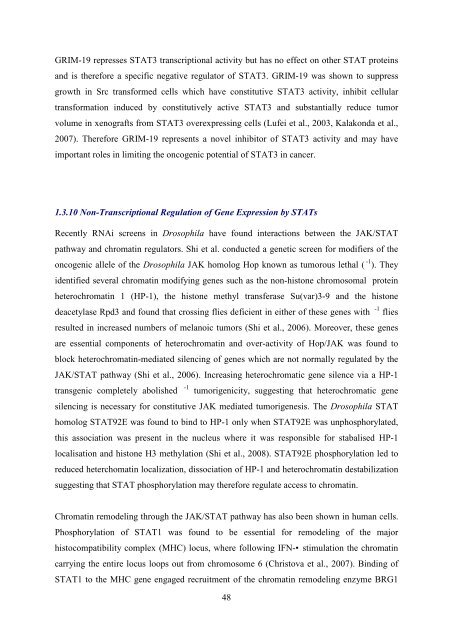Investigating the role of the JAK/STAT and MAPK ... - UCL Discovery
Investigating the role of the JAK/STAT and MAPK ... - UCL Discovery
Investigating the role of the JAK/STAT and MAPK ... - UCL Discovery
You also want an ePaper? Increase the reach of your titles
YUMPU automatically turns print PDFs into web optimized ePapers that Google loves.
GRIM-19 represses <strong>STAT</strong>3 transcriptional activity but has no effect on o<strong>the</strong>r <strong>STAT</strong> proteins<br />
<strong>and</strong> is <strong>the</strong>refore a specific negative regulator <strong>of</strong> <strong>STAT</strong>3. GRIM-19 was shown to suppress<br />
growth in Src transformed cells which have constitutive <strong>STAT</strong>3 activity, inhibit cellular<br />
transformation induced by constitutively active <strong>STAT</strong>3 <strong>and</strong> substantially reduce tumor<br />
volume in xenografts from <strong>STAT</strong>3 overexpressing cells (Lufei et al., 2003, Kalakonda et al.,<br />
2007). Therefore GRIM-19 represents a novel inhibitor <strong>of</strong> <strong>STAT</strong>3 activity <strong>and</strong> may have<br />
important <strong>role</strong>s in limiting <strong>the</strong> oncogenic potential <strong>of</strong> <strong>STAT</strong>3 in cancer.<br />
1.3.10 Non-Transcriptional Regulation <strong>of</strong> Gene Expression by <strong>STAT</strong>s<br />
Recently RNAi screens in Drosophila have found interactions between <strong>the</strong> <strong>JAK</strong>/<strong>STAT</strong><br />
pathway <strong>and</strong> chromatin regulators. Shi et al. conducted a genetic screen for modifiers <strong>of</strong> <strong>the</strong><br />
oncogenic allele <strong>of</strong> <strong>the</strong> Drosophila <strong>JAK</strong> homolog Hop known as tumorous lethal ( -1 ). They<br />
identified several chromatin modifying genes such as <strong>the</strong> non-histone chromosomal protein<br />
heterochromatin 1 (HP-1), <strong>the</strong> histone methyl transferase Su(var)3-9 <strong>and</strong> <strong>the</strong> histone<br />
deacetylase Rpd3 <strong>and</strong> found that crossing flies deficient in ei<strong>the</strong>r <strong>of</strong> <strong>the</strong>se genes with -1 flies<br />
resulted in increased numbers <strong>of</strong> melanoic tumors (Shi et al., 2006). Moreover, <strong>the</strong>se genes<br />
are essential components <strong>of</strong> heterochromatin <strong>and</strong> over-activity <strong>of</strong> Hop/<strong>JAK</strong> was found to<br />
block heterochromatin-mediated silencing <strong>of</strong> genes which are not normally regulated by <strong>the</strong><br />
<strong>JAK</strong>/<strong>STAT</strong> pathway (Shi et al., 2006). Increasing heterochromatic gene silence via a HP-1<br />
transgenic completely abolished -1<br />
tumorigenicity, suggesting that heterochromatic gene<br />
silencing is necessary for constitutive <strong>JAK</strong> mediated tumorigenesis. The Drosophila <strong>STAT</strong><br />
homolog <strong>STAT</strong>92E was found to bind to HP-1 only when <strong>STAT</strong>92E was unphosphorylated,<br />
this association was present in <strong>the</strong> nucleus where it was responsible for stabalised HP-1<br />
localisation <strong>and</strong> histone H3 methylation (Shi et al., 2008). <strong>STAT</strong>92E phosphorylation led to<br />
reduced heterchomatin localization, dissociation <strong>of</strong> HP-1 <strong>and</strong> heterochromatin destabilization<br />
suggesting that <strong>STAT</strong> phosphorylation may <strong>the</strong>refore regulate access to chromatin.<br />
Chromatin remodeling through <strong>the</strong> <strong>JAK</strong>/<strong>STAT</strong> pathway has also been shown in human cells.<br />
Phosphorylation <strong>of</strong> <strong>STAT</strong>1 was found to be essential for remodeling <strong>of</strong> <strong>the</strong> major<br />
histocompatibility complex (MHC) locus, where following IFN- stimulation <strong>the</strong> chromatin<br />
carrying <strong>the</strong> entire locus loops out from chromosome 6 (Christova et al., 2007). Binding <strong>of</strong><br />
<strong>STAT</strong>1 to <strong>the</strong> MHC gene engaged recruitment <strong>of</strong> <strong>the</strong> chromatin remodeling enzyme BRG1<br />
48
















